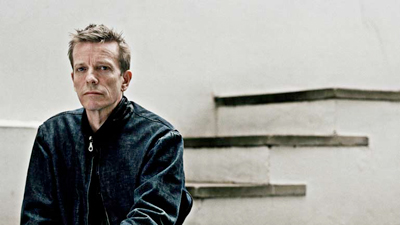by Mike Telin

Simon Fisher Turner began his diverse career as a musician, songwriter, composer, producer, and actor portraying Ned East in the 1971 BBC TV adaptation of Tom Brown’s Schooldays. His musical work in film began with director Derek Jarman, for whom he scored many feature films — from Caravaggio (1986) through to Jarman’s final work, Blue (1993). Turner’s work with the British Film Institute has included composing scores for restorations of the silent films Un Chant D’Amour dir Jean Genet (1950) and The Great White Silence (1924), a British documentary about the Terra Nova Expedition led by Captain Robert Scott.
“Once I saw Noel’s film I realized that I had once again said yes to a project that was bigger and more difficult than I originally thought,” Turner recalled during a telephone conversation. “But after thinking about it, I realized that there was no way I could approach scoring this film the same way that I did with The Great White Silence — I didn’t want to simply repeat the process that I used for that score, so I had to find another one.”
Turner said he began by extensively researching about what was happening in Nepal at the time of Mallory’s and Irvine’s expedition. “I wanted to find out what people were like, what music they were listening to, what Nepal and the Himalayas looked like, and what was physically there at that time,” he said. “Noel’s daughter is still alive, so I met with her a lot — she still his climbing boots. I wanted to know if the original climbers had recorded any video or audio, or even stories. I also got in touch with Chris Bonington, a famous British climber. I talked to cameramen, explorers, musicians — you name them and I spoke to them. I even befriended the Thapa family from Katmandu, who I found with the help of the Embassy in London. I showed them the film, and we talked. It was very difficult to explain to people what I was trying to do without sounding patronizing. But everybody realized how extraordinary the film is, so they genuinely gave of themselves, which was very generous. Even though the research took a long time, I feel as though I barely touched the surface.”
Turner said that it was a dream come true to have the time to just explore, although making a decision about the musical style of the score came to him quite slowly, even though he was constantly looking at — and thinking about — the film. “Once I had figured out my main instrumentation, I knew that I also wanted to use brass and temple bells,” he said. “And I knew that I didn’t want to make a tourist film score, and that sonically, I wanted it to be very modern. For film, everything has to be done with pin-prick precision. But this score is very minimal so that the audience can listen to everything and watch the visuals. I wanted the music to hover slightly below the horizon, and I took care that everything would sound nice and have a reason for being there. Again, I wanted it to sound new and modern.”
The project also became a family affair. “I was given some traditional bells, cup gongs, and prayer bowls, and I took my kids to local churches in the countryside and set up the instruments. They’d just play for twenty, twenty-five minutes. I used snippets of those recordings, and in the film it is the kids that are playing them.”
The final score consists of twelve sections, each of which is titled after a mountain in the Himalayan range. “I didn’t include Everest because I thought that would have been a bit much. I also didn’t want titles like ‘young donkey falls over’ or ‘men on blue glacier.’ Titles are always a nightmare for me. The film is very impressive on the large screen, and I have to say that it sounds absolutely beautiful. It gives you lots of room to think, particularly now because of the Nepalese earthquakes, which have been devastating.”
The score is available for purchase, and Turner has performed it live on three occasions. “The best way to perform it is with a quartet of guitar, trumpet, cello, and piano. We use the film soundtrack as the backing track and play on top of that. It works beautifully as long as there aren’t too many live musicians, because then you just start clogging everything up musically.”
With the Everest project behind him, how is Simon Fisher Turner occupying his artistic life? “I’m kind of drained after a film like that, and it takes time to recover. But usually something comes along and I think, ‘Oh, that’s interesting, I could do that.’ At the moment I’m playing live music to a silent German film called A Symphony of the City, which is about Berlin and was made between the wars, in 1927. It’s 90 minutes and is totally different from the Everest film.”
Published on ClevelandClassical.com June 16, 2015.
Click here for a printable copy of this article




